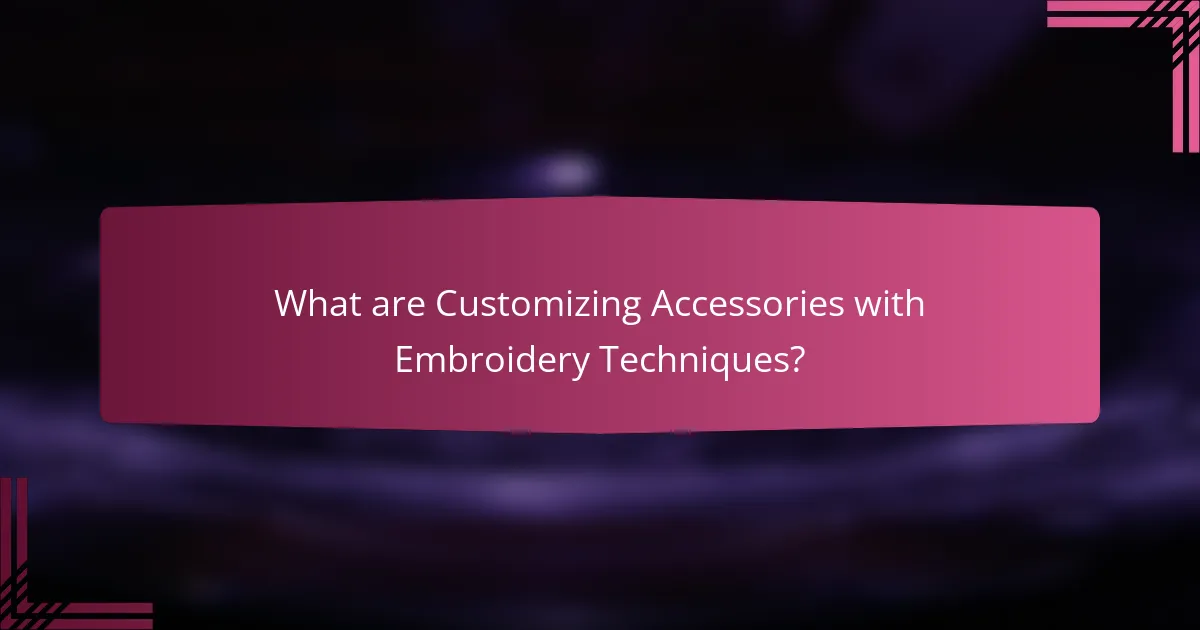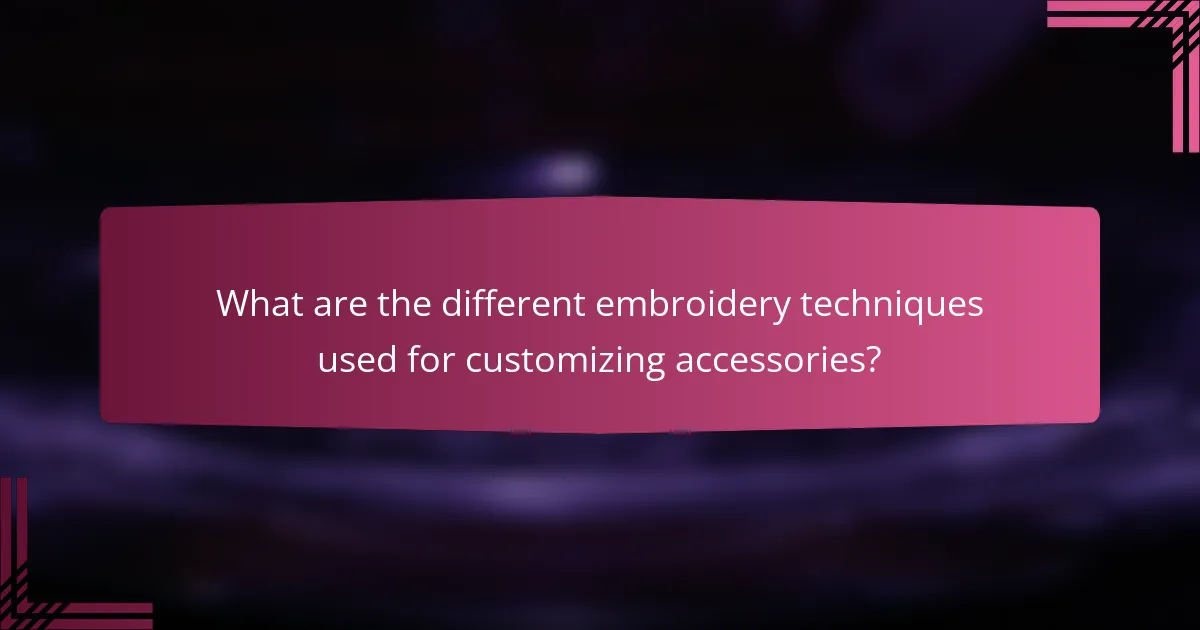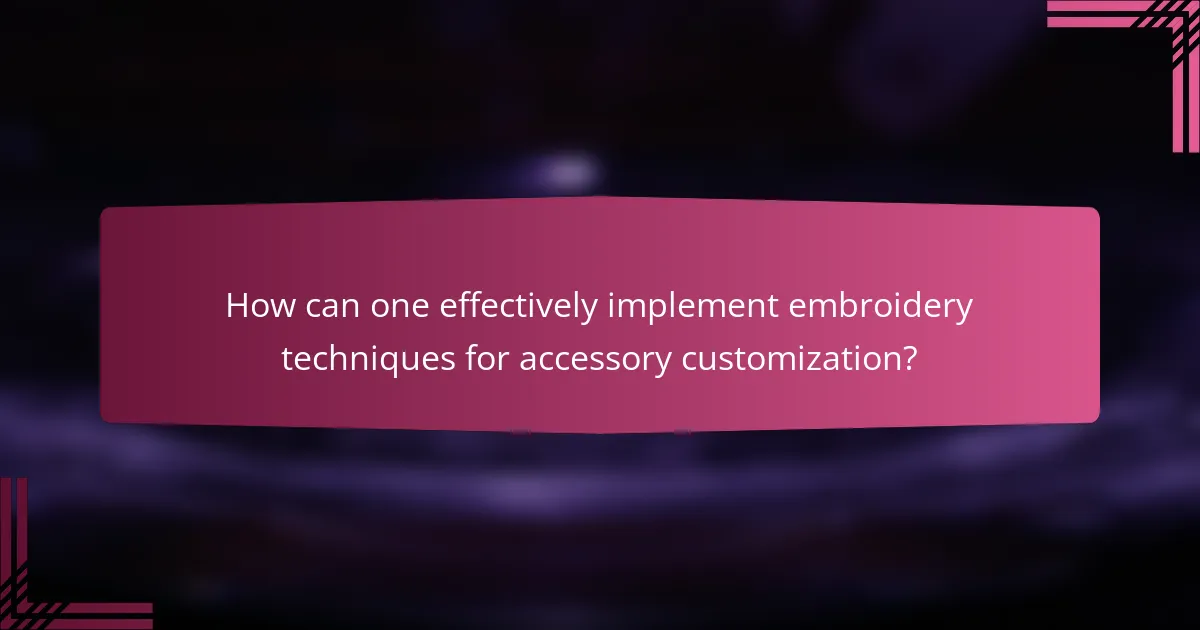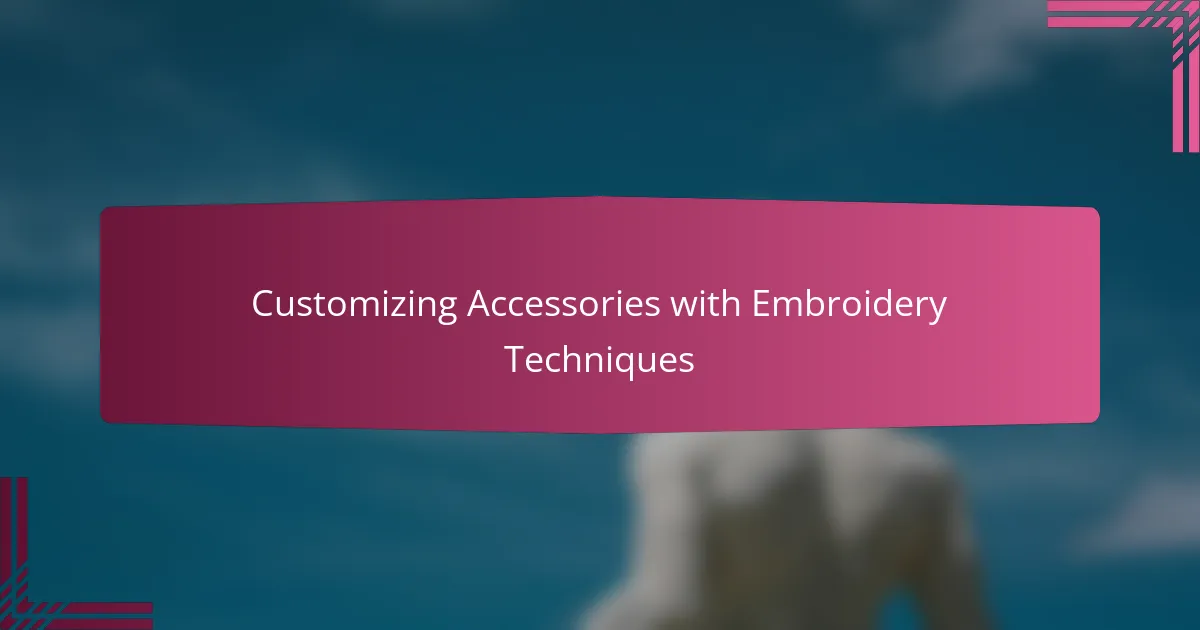
What are Customizing Accessories with Embroidery Techniques?
Customizing accessories with embroidery techniques involves adding personalized designs to various items. This process enhances the aesthetic appeal of accessories such as bags, hats, and clothing. Embroidery techniques include machine embroidery and hand embroidery. Machine embroidery uses computerized machines for precision and speed. Hand embroidery allows for more intricate, personalized designs. Customization can involve logos, names, or unique patterns. According to a report by the Craft and Hobby Association, personalized items are increasingly popular among consumers. This trend indicates a growing market for customized embroidered accessories.
How do embroidery techniques enhance accessory customization?
Embroidery techniques enhance accessory customization by allowing intricate designs and personal expressions. These techniques enable the addition of unique patterns, colors, and textures to various accessories. Custom embroidery can transform ordinary items into personalized statements. This level of customization caters to individual tastes and preferences. For example, embroidered initials or logos can signify ownership or brand identity. The versatility of embroidery techniques accommodates various materials, including fabric, leather, and more. Statistics indicate that personalized accessories are increasingly popular, with 70% of consumers valuing unique items. Overall, embroidery significantly enriches the customization experience for accessories.
What types of accessories can be customized with embroidery?
Accessories that can be customized with embroidery include hats, bags, jackets, and scarves. Hats often feature embroidered logos or designs. Bags can showcase names or unique patterns through embroidery. Jackets allow for personalization with initials or artwork. Scarves can be adorned with custom text or motifs. Other items include aprons, keychains, and patches. Embroidery enhances the aesthetic and personal touch of these accessories.
How does embroidery differ from other customization methods?
Embroidery differs from other customization methods by utilizing thread to create designs on fabric. This technique offers a textured and durable finish that is often more long-lasting than printing or painting. Embroidery can achieve intricate details that may not be possible with other methods. Unlike screen printing, which applies ink to the surface, embroidery stitches through the material, enhancing longevity. Additionally, embroidery can be done on various fabrics, including cotton, polyester, and denim. This versatility allows for a wide range of applications, from clothing to accessories. The tactile quality of embroidery adds a unique dimension that digital prints lack. Overall, embroidery stands out for its durability, detail, and versatility in fabric customization.
What are the benefits of using embroidery techniques for customization?
Embroidery techniques offer several benefits for customization. They provide a durable and long-lasting finish compared to other methods. Embroidery can create intricate designs that enhance the aesthetic appeal of accessories. This technique allows for personalization, making items unique to the owner. Additionally, embroidery can be applied to various fabrics, expanding customization options. It also adds a tactile quality that enhances the overall experience of the accessory. Custom embroidered items often convey a sense of quality and craftsmanship. As a result, they can improve brand recognition and loyalty for businesses.
How does embroidery improve the aesthetic appeal of accessories?
Embroidery enhances the aesthetic appeal of accessories by adding intricate designs and textures. It transforms plain items into visually striking pieces. This art form allows for personalization, making accessories unique to the wearer. Embroidered elements can incorporate various colors and patterns that attract attention. According to a study by the Fashion Institute of Technology, embroidered accessories can increase perceived value by up to 30%. Overall, embroidery elevates the visual interest and individuality of accessories.
What practical advantages does embroidery offer in terms of durability?
Embroidery offers practical advantages in terms of durability by creating strong, long-lasting designs. The stitching method used in embroidery reinforces the fabric, making it less likely to fray or wear out. This technique can withstand frequent washing and exposure to the elements. Unlike printed designs, which can fade or peel, embroidered patterns retain their appearance over time. Additionally, the use of high-quality threads enhances the durability of the finished product. Studies show that embroidered items can last significantly longer than their non-embroidered counterparts, often maintaining their integrity for years.

What are the different embroidery techniques used for customizing accessories?
The different embroidery techniques used for customizing accessories include machine embroidery, hand embroidery, and appliqué. Machine embroidery utilizes computerized machines to create intricate designs quickly and efficiently. This method is ideal for larger production runs and offers consistency in design. Hand embroidery involves stitching designs manually, allowing for unique, personalized touches. This technique is often used for one-of-a-kind pieces. Appliqué involves sewing a piece of fabric onto another fabric to create a design, adding texture and dimension. Each technique provides distinct advantages, catering to various customization needs in accessory design.
How do various embroidery techniques differ from one another?
Various embroidery techniques differ in their methods, stitches, and intended effects. For example, hand embroidery uses manual stitching techniques, while machine embroidery employs automated processes. Cross-stitch creates a pixelated effect using X-shaped stitches. In contrast, satin stitch produces smooth, filled areas with closely spaced parallel stitches. Additionally, appliqué involves sewing fabric pieces onto a base fabric, adding dimension and texture. Each technique also varies in complexity and time investment. For instance, hand embroidery is often more time-consuming than machine embroidery. Understanding these differences helps in choosing the appropriate technique for customizing accessories.
What is the process for machine embroidery?
The process for machine embroidery involves several key steps. First, a design is created or selected using embroidery software. Next, the fabric is hooped securely to ensure stability during stitching. The machine is then threaded with the appropriate thread color. After that, the design is uploaded to the embroidery machine. The machine begins stitching the design onto the fabric, following the programmed instructions. Finally, once the stitching is complete, the fabric is unhooped, and any excess threads are trimmed. Each step is essential for achieving a high-quality embroidered product.
What are the characteristics of hand embroidery?
Hand embroidery is characterized by its intricate designs created using needle and thread. It involves various stitching techniques, such as satin stitch, cross stitch, and chain stitch. Each technique contributes to the texture and visual appeal of the fabric. Hand embroidery allows for personalized designs, making each piece unique. The process is labor-intensive and often requires significant skill and patience. It can be applied to a variety of materials, including cotton, silk, and linen. Hand embroidery is often used to enhance clothing, accessories, and home decor items. Historical records indicate that hand embroidery has been practiced for centuries across different cultures, showcasing its enduring popularity.
What factors should be considered when choosing an embroidery technique?
When choosing an embroidery technique, consider the fabric type, design complexity, and intended use. Different fabrics require specific techniques for optimal results. For example, delicate fabrics may need hand embroidery, while sturdier fabrics can accommodate machine techniques. Design complexity affects the choice of technique; intricate designs often benefit from digitized machine embroidery. The intended use of the item also influences the technique; items for heavy wear may require more durable stitching methods. Additionally, thread type and color can impact the final appearance. Understanding these factors ensures the chosen technique complements the accessory effectively.
How does the fabric type influence the choice of embroidery technique?
The fabric type significantly influences the choice of embroidery technique. Different fabrics have varying weights, textures, and stretch characteristics. For example, lightweight fabrics like silk require delicate techniques such as hand embroidery or fine machine stitching. Heavier fabrics, such as denim, can accommodate more robust techniques like appliqué or thicker thread work. Stretch fabrics, like spandex, benefit from techniques that maintain elasticity, such as specialized stretch stitches. Additionally, the texture of the fabric affects thread choice; smooth fabrics work well with finer threads, while textured fabrics may require thicker threads to stand out. Overall, selecting the appropriate embroidery technique based on fabric type ensures optimal results and durability.
What role does the design complexity play in selecting an embroidery method?
Design complexity significantly influences the selection of an embroidery method. Simple designs can be executed using basic techniques like flat embroidery. These methods are cost-effective and time-efficient. In contrast, intricate designs require advanced techniques such as digitized embroidery or 3D puff embroidery. These methods accommodate detailed patterns and multiple thread colors. The choice of method also impacts the final product’s quality and durability. For example, complex designs may necessitate specialized machines and skilled operators to ensure precision. Therefore, understanding design complexity is crucial for selecting the appropriate embroidery method.

How can one effectively implement embroidery techniques for accessory customization?
To effectively implement embroidery techniques for accessory customization, one should start by selecting the right materials. Choose high-quality fabrics and threads that complement the accessory. Next, design a clear pattern or motif to guide the embroidery process. Use an embroidery hoop to keep the fabric taut while stitching. Employ various embroidery stitches such as satin, backstitch, or French knots to add texture and detail. Ensure consistent tension in the thread for a polished finish. Finally, finish the edges neatly to prevent fraying and enhance durability. These steps lead to a professional-looking customized accessory.
What tools and materials are necessary for embroidery customization?
Essential tools and materials for embroidery customization include embroidery floss, needles, and fabric. Embroidery floss is a type of thread that comes in various colors and is used for stitching designs. Needles, specifically embroidery needles, have a larger eye to accommodate multiple strands of floss. Fabric serves as the base for embroidery and can vary from cotton to linen. Additionally, an embroidery hoop is necessary to keep the fabric taut while stitching. Scissors are also required for cutting threads and finishing touches. Lastly, a water-soluble marker can be useful for transferring designs onto fabric. These tools and materials are fundamental for creating customized embroidered accessories.
What types of threads and fabrics work best for embroidery?
The best types of threads for embroidery include cotton, polyester, and rayon. Cotton threads are durable and provide a matte finish. Polyester threads are strong and resistant to fading and shrinking. Rayon threads offer a shiny appearance and are smooth for intricate designs.
The ideal fabrics for embroidery are cotton, linen, and polyester blends. Cotton fabrics provide a stable base for stitching. Linen offers a natural texture that enhances the design. Polyester blends combine durability with a smooth surface, making them suitable for various projects.
These threads and fabrics are commonly used in the embroidery industry. Their properties ensure high-quality results and longevity in embroidered items.
How do different embroidery machines compare for accessory customization?
Different embroidery machines vary significantly in their capabilities for accessory customization. High-end machines often feature advanced software that allows for intricate designs and personalized patterns. They typically support multiple thread types and colors, enhancing design flexibility. Mid-range machines may offer basic customization options but often lack the advanced features of premium models. Entry-level machines usually provide limited customization, focusing on simple designs.
For instance, machines like the Brother PE800 enable users to import custom designs, while others like the Singer 9960 offer a variety of built-in stitches but less flexibility for unique patterns. Additionally, the ease of use and setup time can differ, impacting how quickly users can start customizing accessories. The speed of embroidery and the size of the embroidery area also play critical roles in determining the efficiency of customization tasks.
What are the best practices for creating custom embroidered accessories?
The best practices for creating custom embroidered accessories include selecting high-quality materials. Quality fabrics ensure durability and enhance the final appearance of the embroidery. Next, use appropriate thread types that complement the fabric. Polyester threads are often preferred for their strength and colorfastness.
Design selection is crucial. Choose designs that are not overly complex to ensure clarity in the final product. Proper digitization of the design is essential. This process translates artwork into a format the embroidery machine can understand, impacting the stitch quality.
Testing the design on a sample fabric is recommended. This allows for adjustments before the final production. Finally, maintain the embroidery machine regularly. Regular maintenance ensures consistent performance and quality in the finished accessories.
How can one ensure high-quality results in embroidery customization?
To ensure high-quality results in embroidery customization, one must focus on several key factors. First, selecting high-quality materials is essential. This includes using premium threads and fabrics that are durable and suitable for embroidery. Second, proper digitization of the design is crucial. Accurate digitization translates the design into a format that the embroidery machine can read effectively. Third, maintaining the embroidery machine is vital. Regular cleaning and servicing prevent issues that can lead to poor outcomes. Fourth, using appropriate stabilizers enhances the quality of the embroidery. Stabilizers provide support to the fabric during the stitching process. Fifth, testing the design on a sample fabric helps identify potential issues before the final product. Lastly, attention to detail during the stitching process ensures precision and quality. Following these steps can significantly improve the quality of embroidered customizations.
What common mistakes should be avoided during the embroidery process?
Common mistakes to avoid during the embroidery process include improper hooping, incorrect thread tension, and inadequate fabric preparation. Improper hooping can lead to distorted designs and uneven stitches. Incorrect thread tension may cause thread breakage or bunching, affecting the final appearance. Inadequate fabric preparation can result in shifting or puckering during stitching. Additionally, neglecting to test designs on scrap fabric can lead to unexpected results. Failing to clean the embroidery machine regularly may also impact performance and stitch quality. Each of these mistakes can compromise the overall quality of the embroidered accessory.
What tips can help beginners start customizing accessories with embroidery techniques?
Start with simple designs. Beginners should choose basic shapes or letters for their first projects. Use a quality embroidery hoop to keep fabric taut. This ensures even stitching and prevents puckering. Select appropriate thread types for different fabrics. Cotton threads work well on most materials. Practice basic stitches like backstitch and satin stitch. These foundational techniques are essential for more complex designs. Always test your design on a scrap piece of fabric first. This helps avoid mistakes on the actual accessory. Lastly, be patient and take your time. Mastery comes with practice and experimentation.
Customizing accessories with embroidery techniques involves enhancing various items such as bags, hats, and clothing through personalized designs. Key methods include machine and hand embroidery, each offering unique benefits in terms of precision and detail. The article explores the advantages of embroidery for customization, including durability and aesthetic appeal, while also discussing the types of accessories that can be customized and the different techniques available. Additionally, it addresses best practices, common mistakes, and tips for beginners to effectively implement embroidery in their accessory designs.
